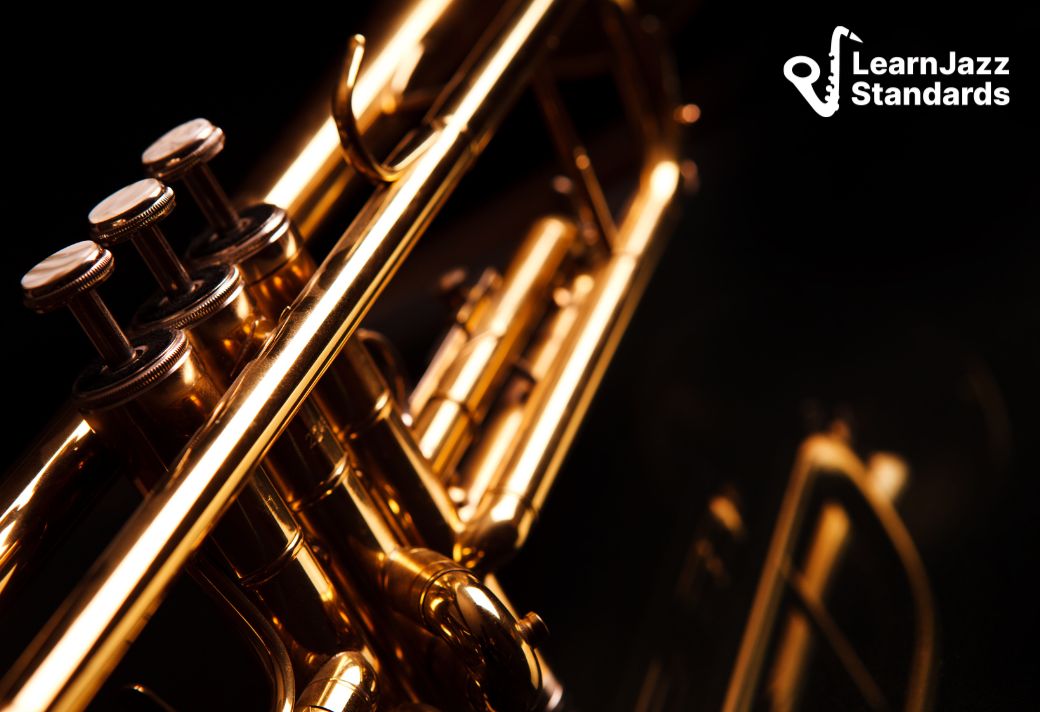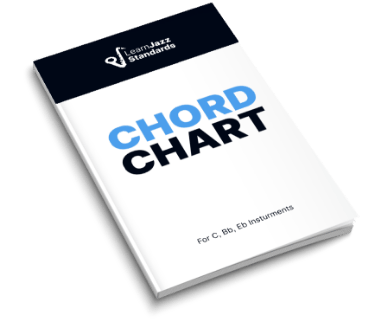Diminished chords are one of the most versatile and least understood tools in your musician’s toolbox! Understanding how jazz musicians utilize diminished chord progressions is essential for truly mastering your craft.
That’s why we’re going to explore five crucial diminished chord progressions found across many jazz standards. Memorize these five diminished jazz chord progressions, their variations, and the theory behind them, and you’ll be well on your way to being a more well-rounded jazz musician.
We’ll discuss:
- What diminished chords are and where they come from
- Common diminished chord functions in jazz
- 5 common diminished chord progressions you need to know
If you want to take your jazz playing and music theory skills to the next level, check out the Learn Jazz Standards Inner Circle. The Inner Circle has everything you need to cut through all the noise and truly become the best player you can be!
Improve in 30 Days or Less. Join The Inner Circle.
Table of Contents
What Are Diminished Chords?
Before we dive into the chord progressions, we should learn a bit about diminished chords and the different functions they have. You may know a lot about major and minor chords, but what about their dissonant counterpart?
Diminished chords come from the symmetrical diminished scale, but can also be found in other scales. There are two main types of diminished chords you’ll encounter in jazz:
- Diminished triads (B – D – F): Three-note chords that often appear diatonically as passing chords or in minor keys. These triads consist of two minor thirds.
- Fully diminished seventh chords (B – D – F – A♭): Four-note chords that resolve firmly by a half step and are often used as substitutes or connectors. These 7th chords consist of three minor thirds.
We’ll focus on diminished seventh chords in this article, but we should start by briefly describing diminished triads. Check out this article for a deeper dive into diminished chords and the diminished scales they come from.
So, how do we build diminished chords?
Diminished triads are created by stacking minor thirds over a root note. A minor third is equivalent to three half steps. Let’s start with a B and stack minor thirds until we have a three-note B diminished triad.
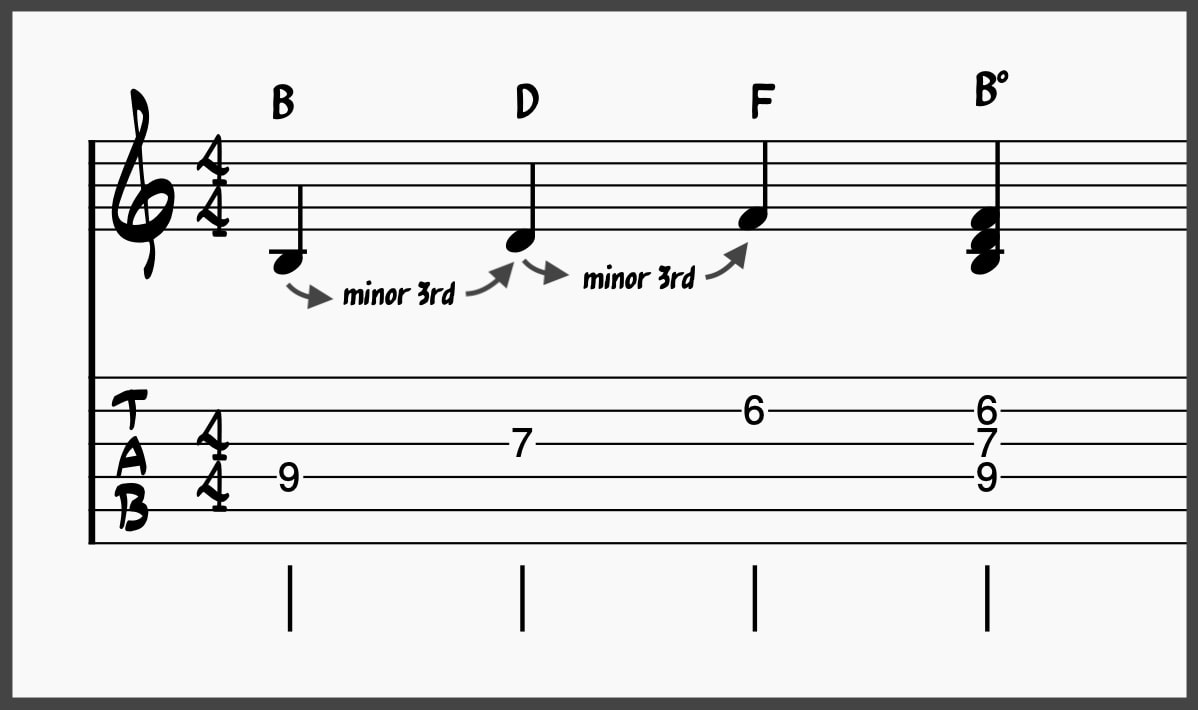
A diminished triad is one of the diatonic triads, along with major and minor triads. In other words, it is one of the triads you get when you harmonize the major scale. Specifically, the diminished triad occurs on the seventh scale degree or leading tone of the major scale.
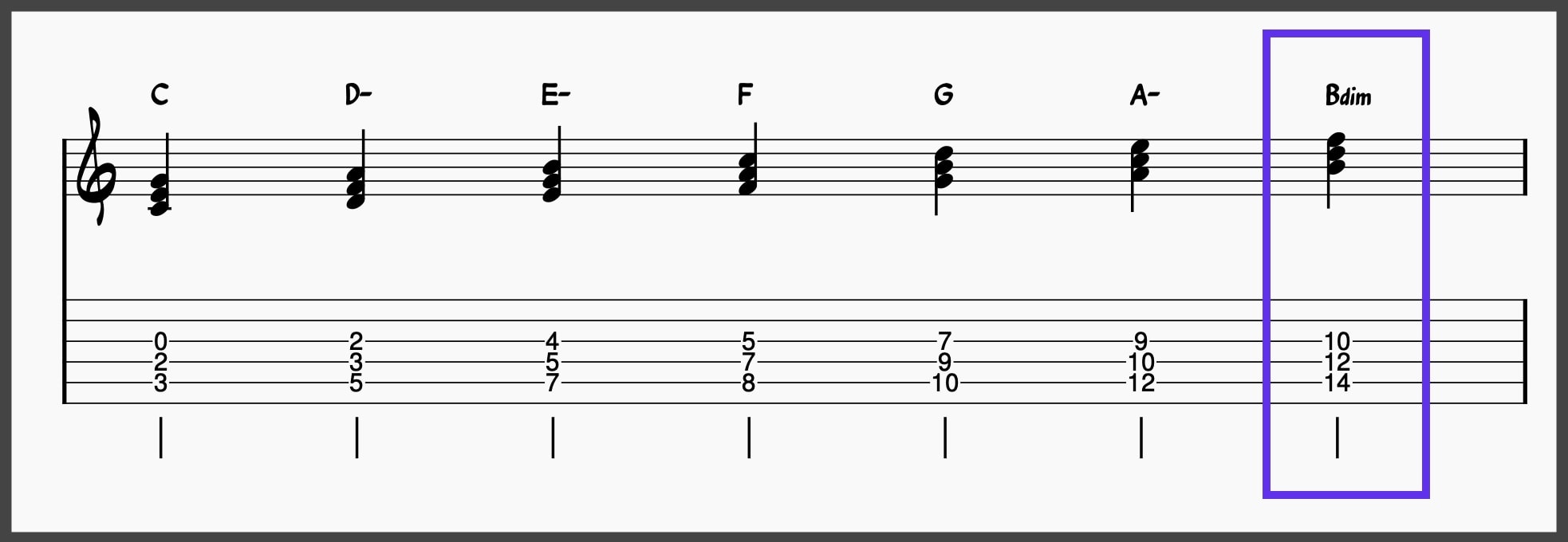
Check out this article to learn more about diatonic chords, and this one for more on scale degrees.
However, we’re here to explore diminished seventh chords, which are far more common in jazz chord progression. With diminished seventh chords, we stack an additional minor third on top of our diminished triad.
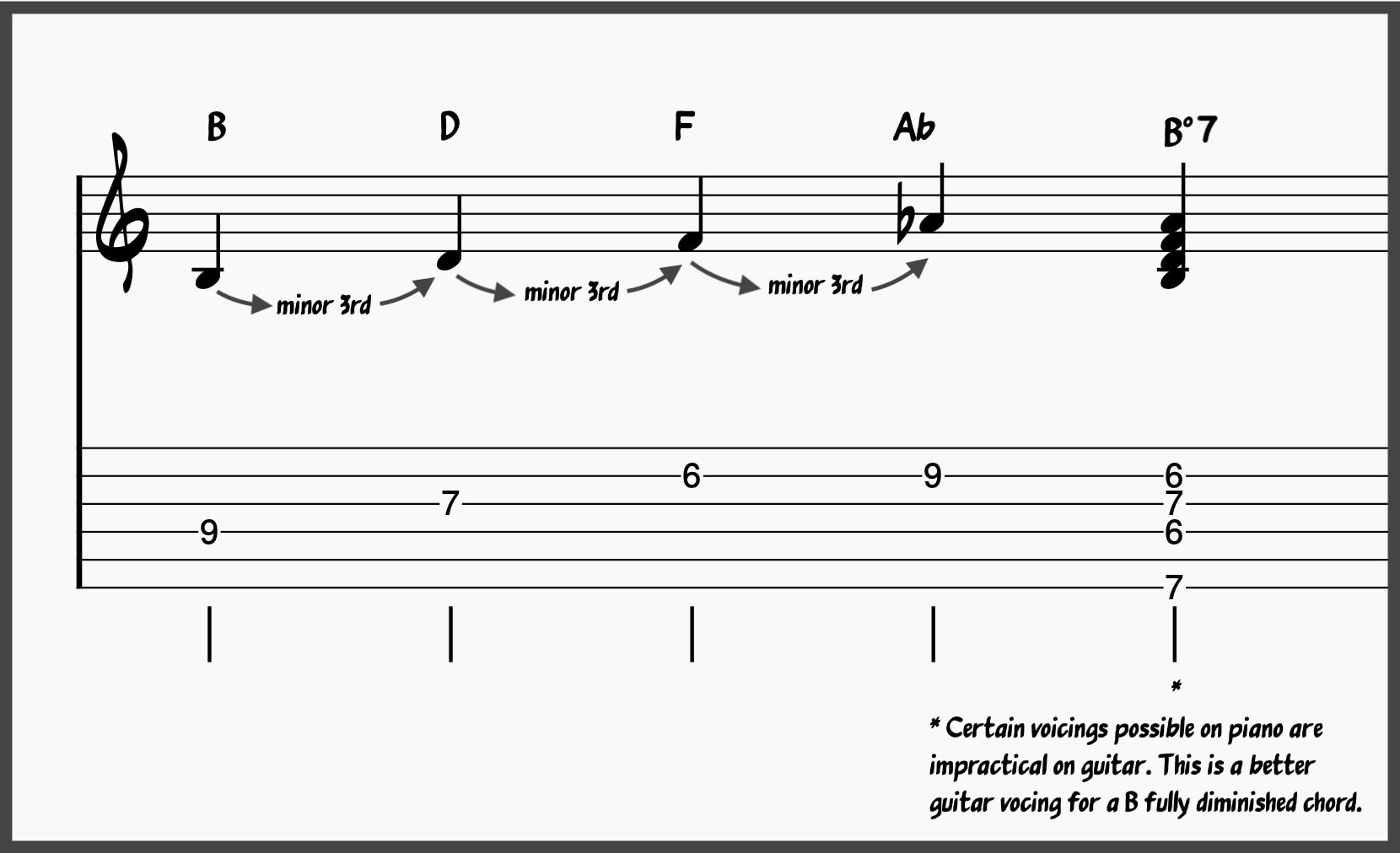
The addition of the Ab makes this fully diminished chord non-diatonic to major and natural minor keys. The diatonic variation of the fully diminished chord is the half-diminished chord.
A half-diminished seventh chord consists of a diminished triad and a minor seventh interval from the root. Instead of an Ab, you’d have an A natural. The half-diminished seventh chord is built from the seventh scale degree of the major scale.
Check out this article to learn more about the half-diminished seventh chord.
Where Do Diminished Seventh Chords Come From?
Two commonly used scales contain fully diminished chords.
Harmonic Minor Scale
Fully diminished 7th chords are found in the harmonic minor scale, on the 7th scale degree. That chord is highlighted in purple below.

Check out this post to learn more about using the harmonic minor scale.
Minor chord progressions that borrow from harmonic minor might use the viio7 chord found on the 7th scale degree of the harmonic minor scale.
Diminished Scales
The diminished scale is an octatonic (eight-note) scale built by alternating half-steps and whole steps—or vice versa, depending on where you start:
- Half-Whole: H–W–H–W–H–W–H–W
- Whole-Half: W–H–W–H–W–H–W–H
These two variations form the two modes of the diminished scale:
- Half-Whole Diminished Scale (also called the Dominant Diminished Scale)
- Whole-Half Diminished Scale
Here is the Half Whole Diminished Scale. Each octave of the scale contains two fully diminished chords. In this example, we have a C diminished seventh chord and a Db diminished seventh chord.
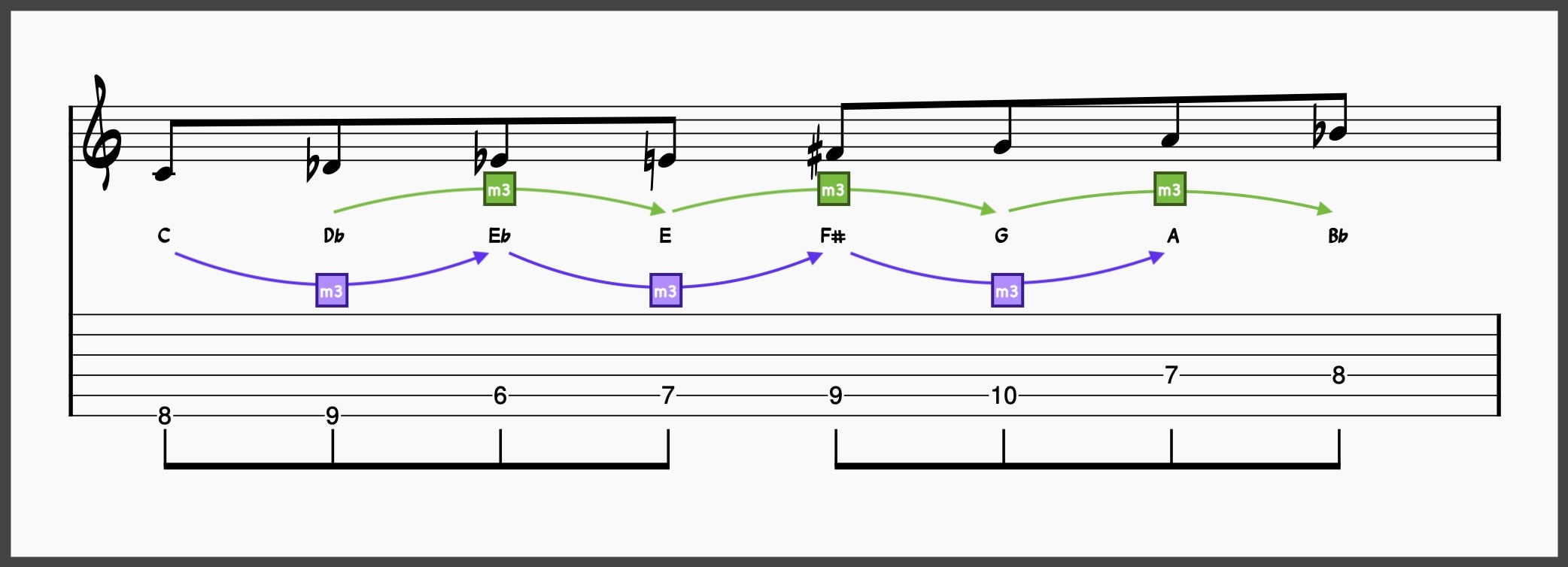
Diminished Chord Applications in Jazz Chord Progressions
Now that we know what diminished chords are and where they come from, let’s talk about how to use them to play jazz!
In this section, we’ll cover four primary functions diminished chords have in jazz chord progressions. Also, note that a diminished chord can serve multiple functions at once, so these three functions can and often do overlap.
For example, a diminished chord can be substituted for a secondary dominant while also acting as a chromatic passing chord.
Substitution Functions
Diminished chords often replace dominant and dominant-functioning chords due to their similar voice leading and harmonic functions. This means a reduced chord can replace the dominant chord or a secondary dominant chord in a progression.
We’ll explore many examples of this below, so we’ll be sure to point out when diminished chords are substituting for dominant and secondary dominant chords.
Check out this article to learn more about secondary dominant chords.
Chromatic Passing Chord Function
Diminished chords are often used to connect two diatonic chords via chromatic voice leading. These types of diminished progressions frequently appear in jazz turnarounds, a specific kind of jazz chord progression that returns to the beginning of a section or the start of the tune.
We’ll see many examples of this function in the diminished progressions below. We’ll be sure to point these out!
Check out this article to learn more about jazz turnarounds.
Cadential Functions
Since diminished seventh chords can function as dominant chords, they can often be used to imply the V in a V-I cadence or even a IV in a IV-I cadence.
Check out this article to learn more about musical cadence types.
Functions in Minor Keys
We noted above that diminished triads are diatonic, but fully diminished chords do not occur in the major and natural minor scales and are therefore non-diatonic.
However, fully diminished chords do occur in the harmonic minor scale.
BEFORE YOU CONTINUE...
If music theory has always seemed confusing to you and you wish someone would make it feel simple, our free guide will help you unlock jazz theory secrets.

5 Diminished Chord Progressions
Now that we’ve covered diminished chords and their primary functions in jazz, we’re ready to explore diminished chords in the wild!
Here are five jazz chord progressions that use diminished chords. As you’ll soon discover, each one of these progressions has several variations you can use to branch out into even more progressions!
That’s because diminished chords are special due to their symmetry and can represent several other chords at once. This concept will be discussed later in the article.
1. I –♭ii°7 – ii – V7
This first example is a common jazz chord progression, though you might not know it at first glance. Let’s use the key of C to demonstrate.
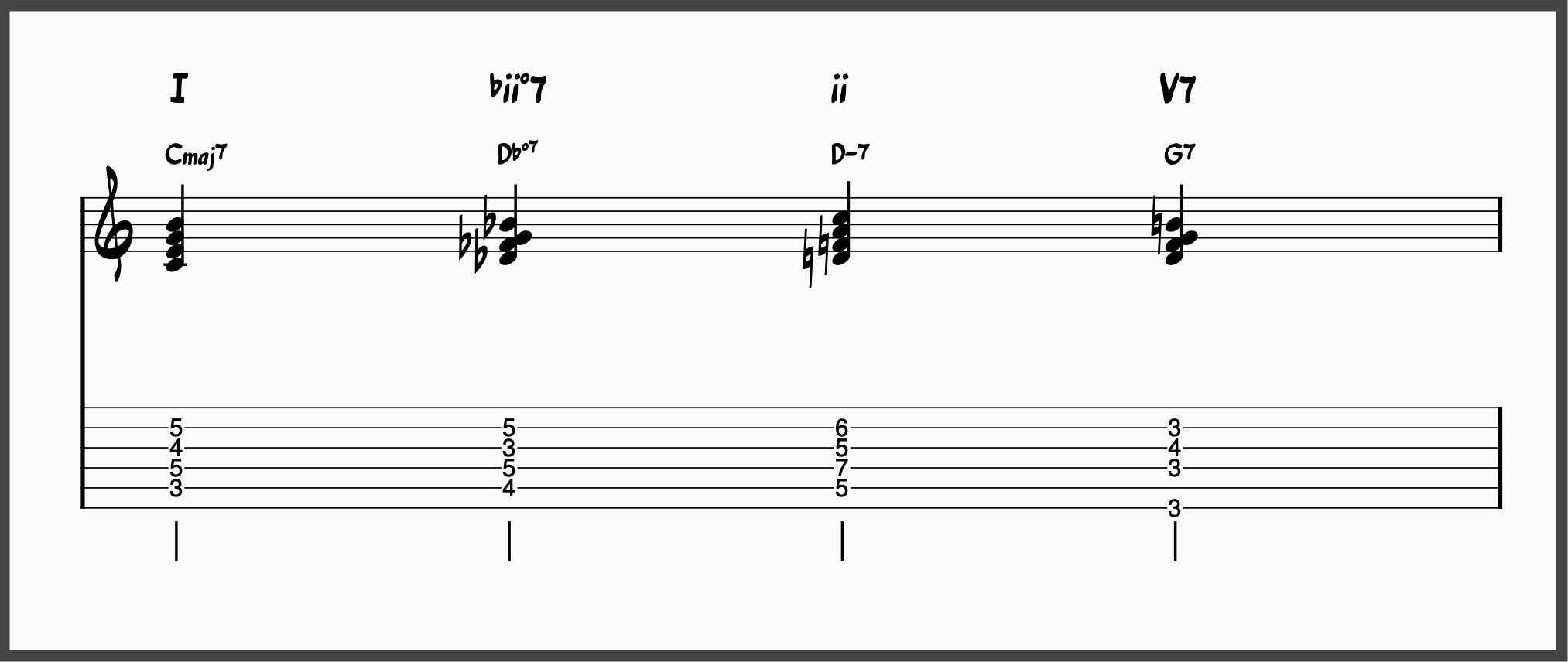
This I –♭ii°7 – ii – V7 chord progression is actually a secret I-VI-ii-V chord progression. A Db°7 chord is a common substitution for an A7 chord. Let’s find out why.
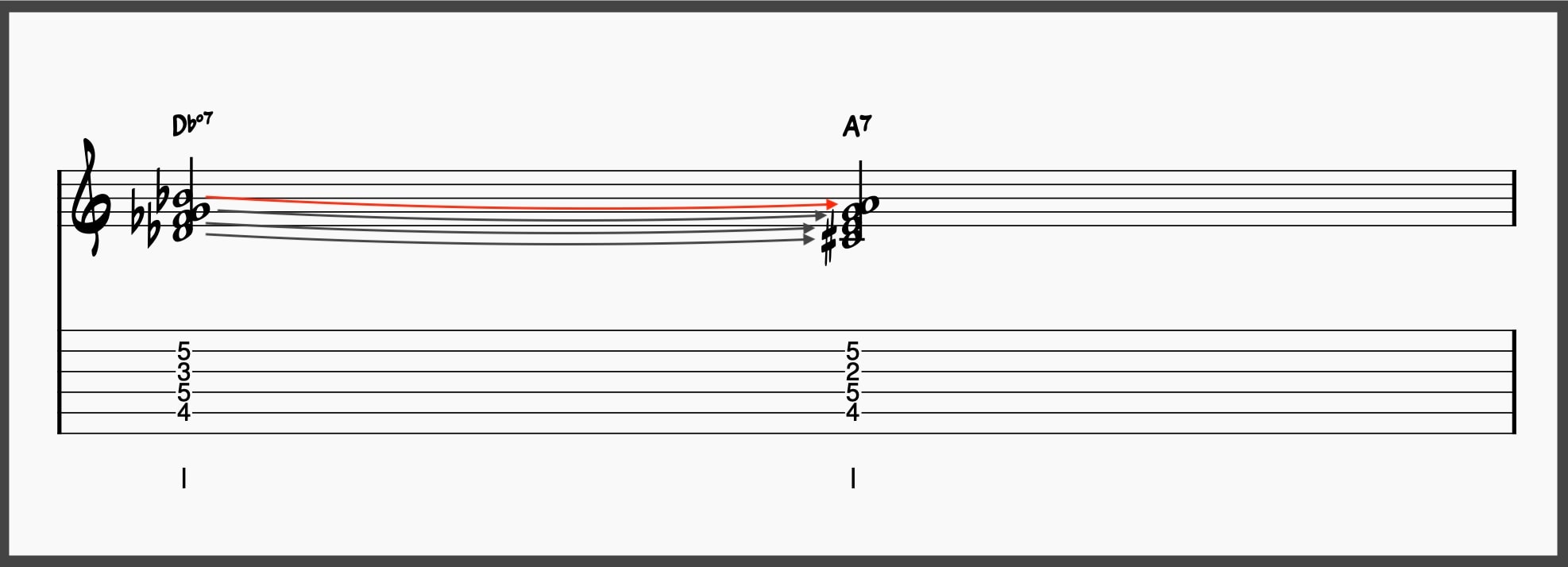
When we consider enharmonic notes, there is only one note difference between a Db°7 chord and an A7 chord.
Db°7 chord
- Bb
- G
- Fb
- Db
A7 Chord
- A
- G
- E
- C#
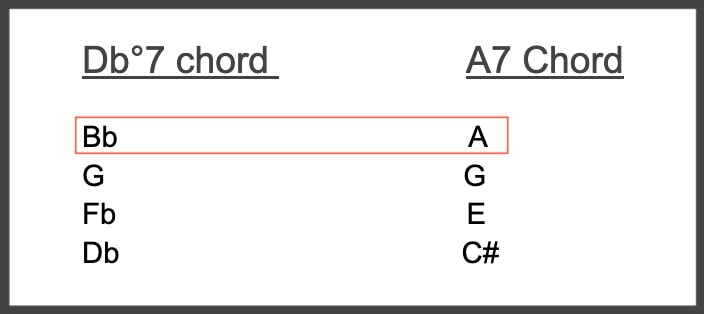
The only difference between a Db°7 chord and an A7 is that a Db°7 has a Bb and an A7 has an A. Therefore, the Db°7 functions in the same way as an A7b9. It is a diminished substitution for a dominant VI chord (which itself is already another type of substitution called a secondary dominant).
Check out this article for more on chord substitutions, like the diminished chord substitution.
Diminished Chord Functions in This Progression
Like the first progression, the diminished chords in this progression serve both as chord substitutions and chromatic passing chords.
Diminished Chord Symmetry
Due to the symmetrical nature of diminished chords, one diminished chord is also three other diminished chords! Because each note in the chord is separated by a minor third and there are four notes in each diminished seventh chord, each inversion of a diminished chord is structurally identical.
Each note is a minor third apart from its adjacent notes. In other words, Db°7 in first inversion is Db°7/Fb (or E), and it is identical to an E°7 chord, whose first inversion is in turn identical to a G°7 chord, which is identical to a Bb°7 when in first inversion.
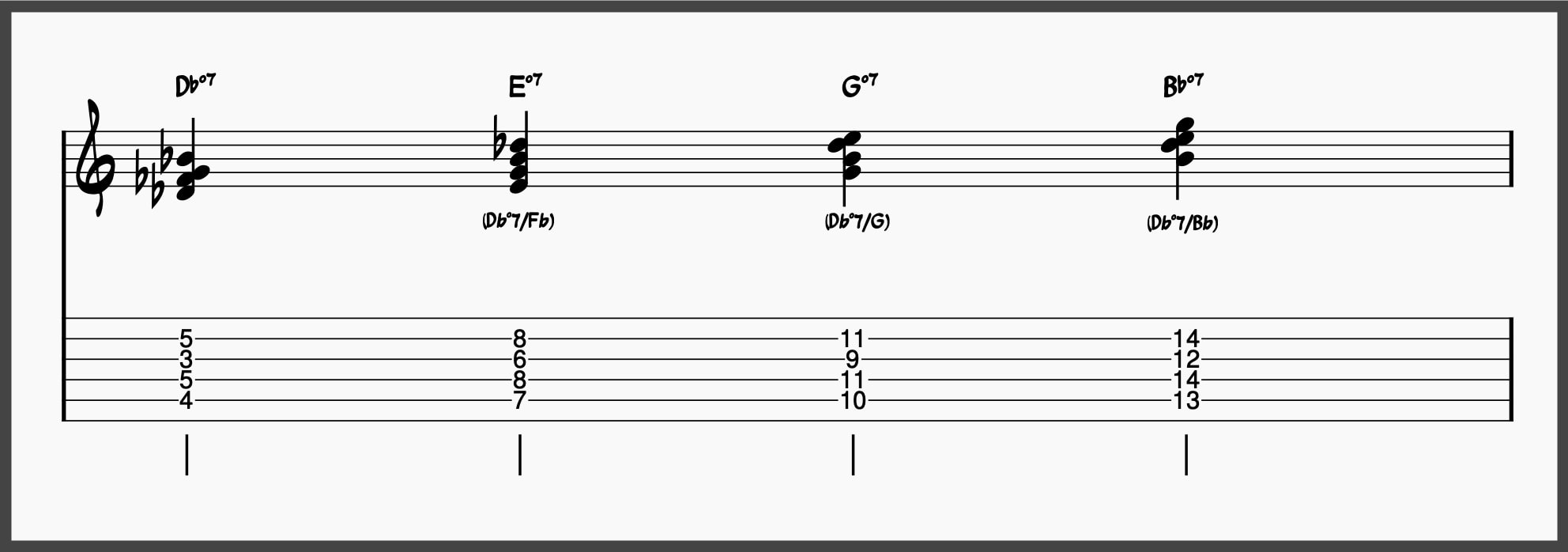
What does this mean practically?
It means there are four different diminished chords you can use to sub out the VI chord in the progression above. The first example above used a Db°7 chord, but you could just as easily use an E°7, G°7, and Bb°7 chord, and it would function as a suitable substitution for an A7 chord.
Therefore, in the key of C, our I –♭ii°7 – ii – V7 progression could also be:
- I – iii°7 – ii – V7 or Cmaj7 – E°7 – D-7 – G7
- I – V°7 – ii – V7 or Cmaj7 – G°7 – D-7 – G7
- I – ♭vii°7 – ii – V7 or Cmaj7 – Bb°7 – D-7 – G7
These will all sound similar, but the value in practicing these variations is twofold:
- You can cycle between these chords within the span of the original dominant chord
- Stick to one to emphasize a different root note for your diminished seventh chord.
2. I –♭ii°7 – ii –♭iii°7 – iii
This next progression builds upon the first one. Not only do we have a diminished seventh chord subbing for a VI chord, but we have an additional diminished seventh chord subbing for a dominant VII7 chord, or V of iii.
What appears as a I –♭ii°7 – ii –♭iii°7 – iii is actually a I – VI – ii – VII – iii chord progression. When you use these particular diminished chords, you get a smooth, chromatic bassline ascending from the I chord up to the iii chord. This progression is often used in Rhythm Changes tunes.
Check out these 9 Rhythm Changes Heads you should learn.
Note the two chords highlighted in purple. These are our diminished seventh chords. You’ll find original chords in parentheses under the staff.
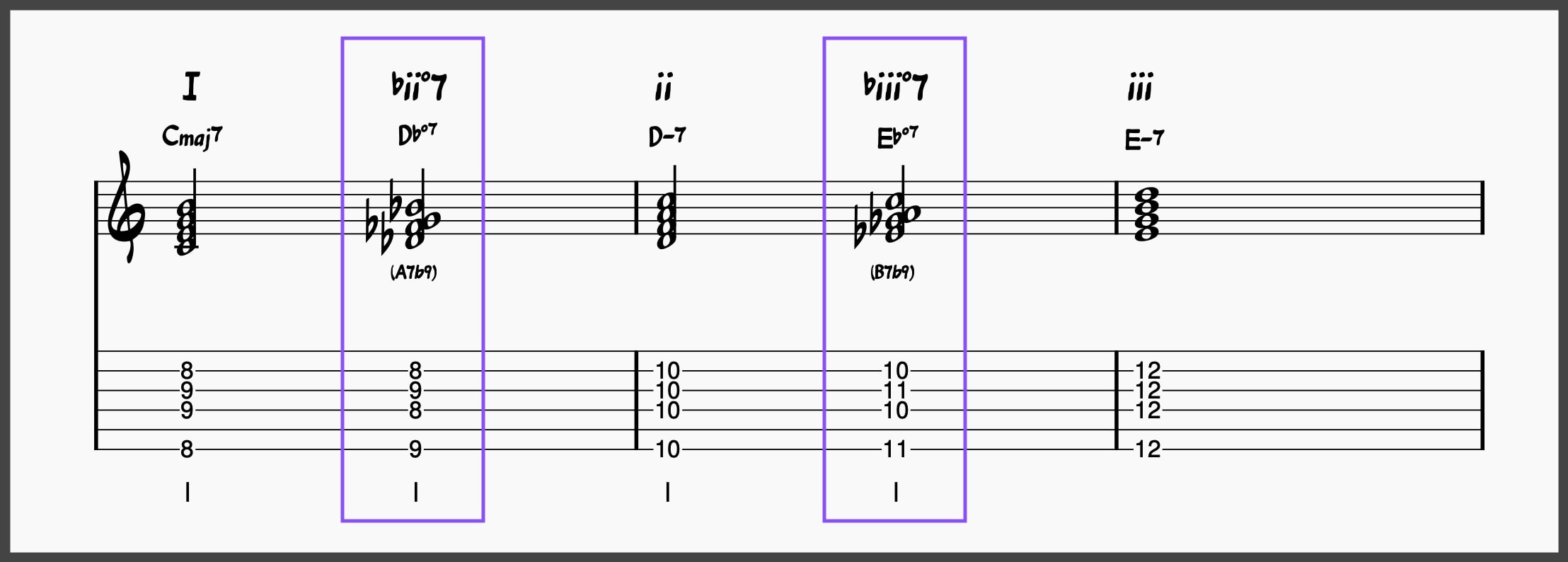
As we discussed above, one diminished chord can be three other diminished chords depending on the inversion you use. Therefore, you could rewrite this progression in many different ways—16 different ways, to be exact!
- Db°7 is functionally identical to E°7, G°7, and Bb°7.
- Eb°7 is functionally identical to F#°7, A°7, and C°7.
When practicing this progression, try each inversion of both diminished chords. Only the version shown in the image above will have a complete chromatic bass line.
Diminished Chord Functions in This Progression
Like the first progression, the diminished chords in this progression serve both as chord substitutions and chromatic passing chords.
3. ii – vii°7 – I
Our next progression is a variation on the ii-V-I progression. If you didn’t know, the ii-V-I progression is the basic building block of jazz harmony. This variation on the ii-V replaces the V chord with a diminished seventh chord built off the seventh scale degree of the tonal center.
In the key of C, we’d have a D-7 – B°7 – Cmaj7.

Like the other progressions, you can replace the B diminished seventh chord with any diminished seventh chord in its series.
- D-7 – B°7 – Cmaj7
- D-7 – D°7 – Cmaj7
- D-7 – F°7 – Cmaj7
- D-7 – Ab°7 – Cmaj7
You can also cycle through these diminished chords within the span of the original V chord.

Diminished Chord Functions in This Progression
The diminished chords used in this example function as chord substitutions for dominant chords.
4. IV7 – #IV°7 – I
Our fourth jazz chord progression occurs in the jazz blues. It is common to turn the IV chord into a #IV diminished chord in the sixth bar of the blues. Check out the jazz blues below and find our progression highlighted in purple.
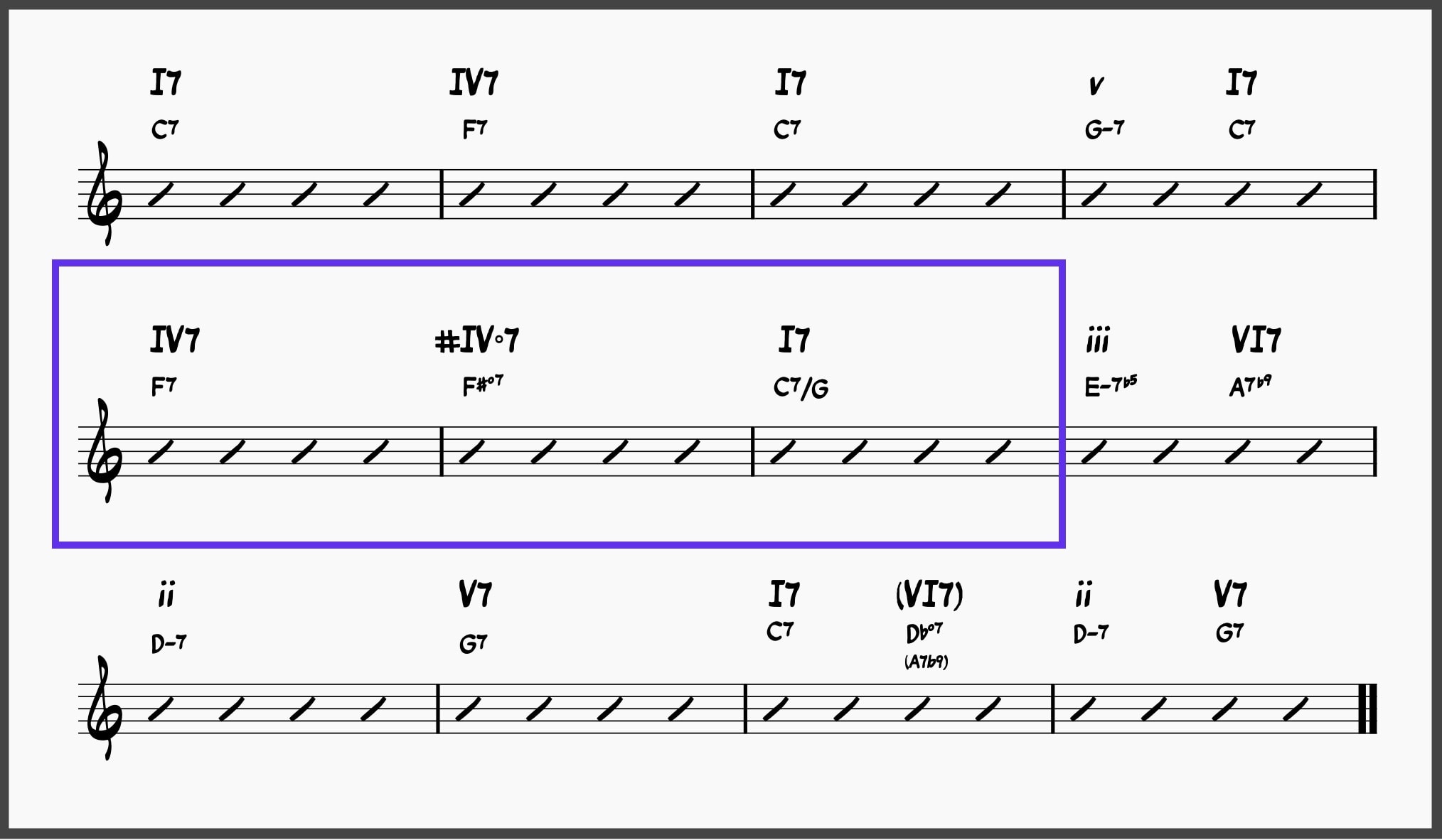
This diminished chord has more to do with voice leading than with chord substitutions. An F#°7 chord has all the same notes as a rootless F7b9 chord. The root note of the F7 chord becomes the b9 when it moves from F to F#.
This chromatic upward movement can last through the resolution back to the I7 chord in the seventh bar if we use an inversion and put that I7 chord over the fifth of the chord. The bass line would then be F to F# to G.
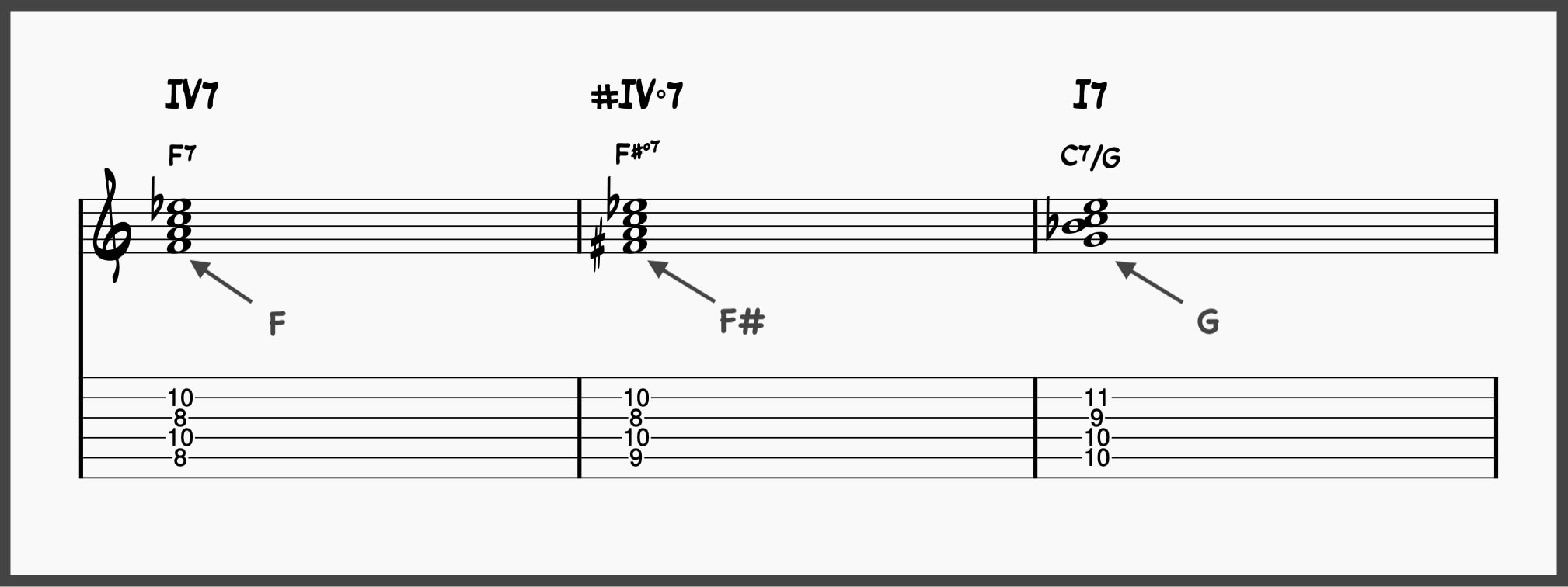
Diminished Chord Functions in This Progression
The diminished chord in this progression serves as a chromatic passing chord to resolve our IV – I cadence.
5. i – vii°7 –♭vii – III7 – bvi°7 – VI (Corcovado)
So far, we’ve focused on major key progressions, but it’s time for a minor key progression that utilizes diminished chords. Progressions like this are common in many minor-key tunes. However, I’ll stick to the changes of one of my favorite tunes—”Corcovado” by Antonio-Carlos Jobim.
For more on Jobim, check out this listicle on the 50 greatest jazz musicians of all time. For more on “Corcovado” specifically, check out this article on Bossa Nova chord progressions.
This progression uses two diminished chords that serve different functions.
- i – vii°7 –♭vii – III7 – bvi°7 – VI
The first diminished chord functions as a chromatic passing chord that takes us from the i chord to the bvii chord. It also shares many of the same notes as the V chord; therefore, it could also be an E7b9/G#. The vii°7 is pulled from the harmonic minor scale, as we discussed above.
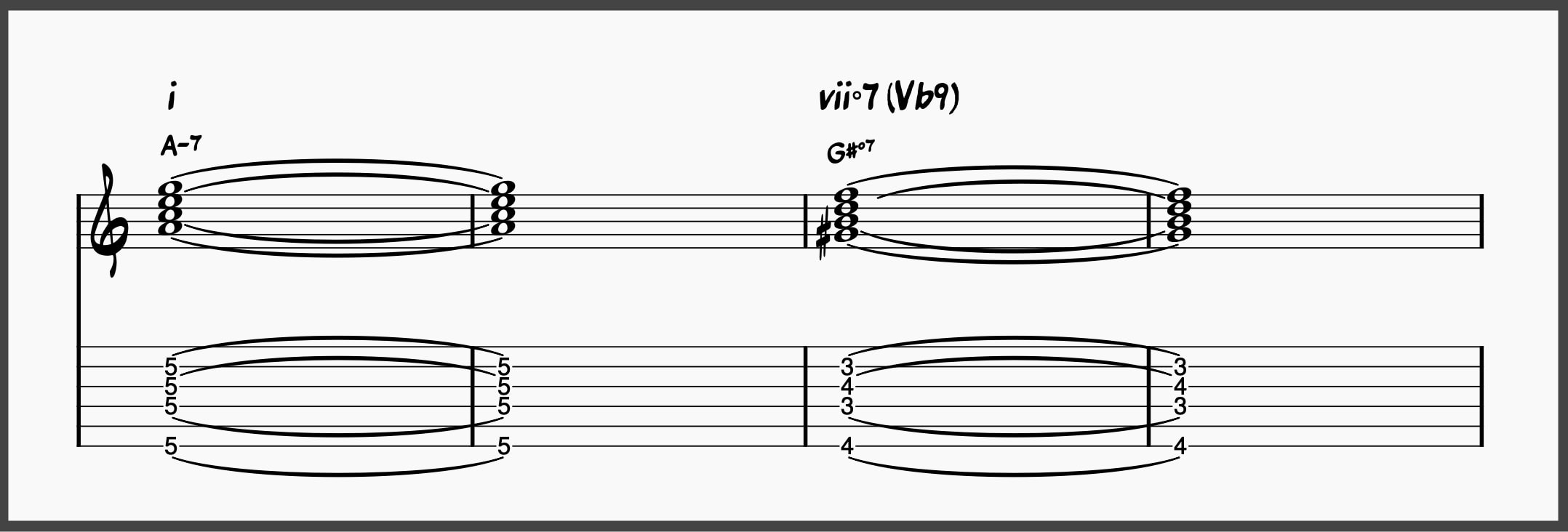
After this, we move to the bvii chord, which is the true vii chord in minor keys. In the following example, the bvii chord will function as a ii chord for a ii-V to the bVI chord. However, before we land on the bVI chord, we first land on a bvi°7 chord.
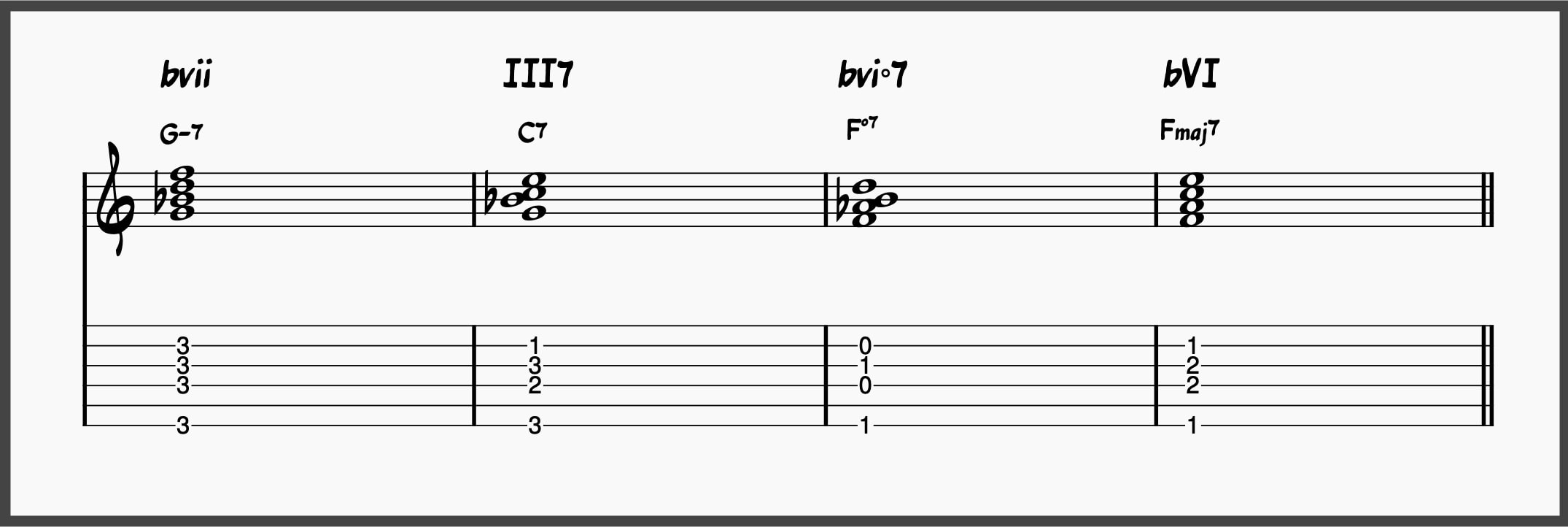
The bvi°7 chord delays the resolution to the VI chord and serves as a chromatic approach chord that resolves upwards by a half step. This extends the tension from the dominant chord in the second bar.
The F diminished here and the G# diminished in the first part of the progression are actually the same chord! Remember the symmetry of diminished chords. G# (or Ab) is a minor third away from F. They are inversions of the same diminished seventh chord.
Here is the progression in its entirety.
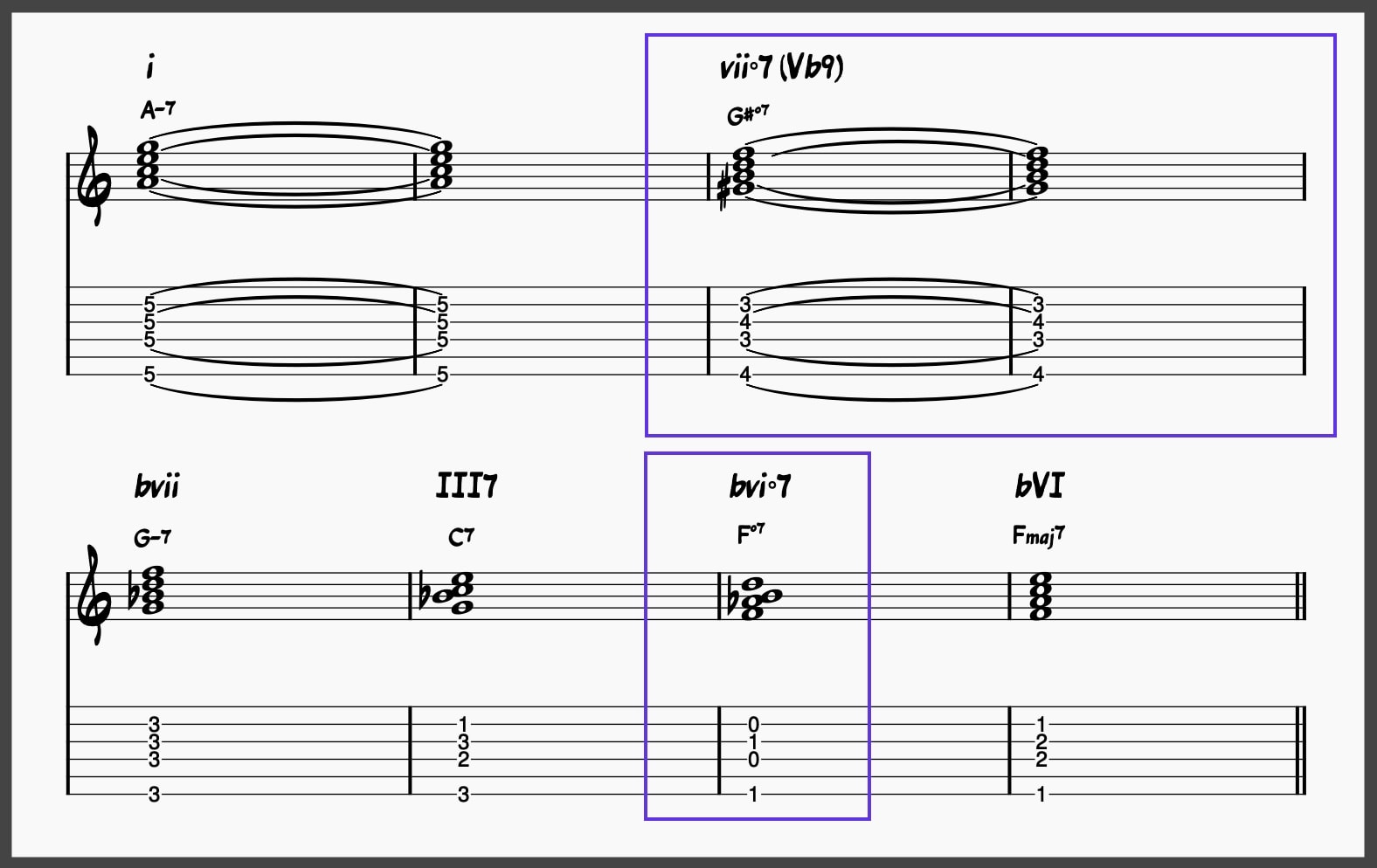
Diminished Chord Functions in This Progression
Despite being technically the same diminished chord, both instances have slightly different functions. The first instance serves as a chromatic passing chord, and the second serves as a chromatic approach chord that delays resolution.
How To Practice Diminished Chord Progressions
We’ve covered a lot of ground in this article!
\We’ve learned what diminished triads and fully diminished seventh chords are and how to construct them. We’ve also learned about the common functions diminished chords have in jazz chord progressions. Then, we went over five practical diminished chord progression scenarios.
Where should you go from here? How should you practice these progressions?
- Map them to all 12 keys
- Comp through them using guide tones, shell voicings, and full chords
- Improvise lines that highlight these diminished resolutions using diminished arpeggios and the diminished scale
- Identify areas where you can insert or substitute diminished chords into jazz standards you know
Need help hearing and internalizing diminished resolutions? The Inner Circle has play-alongs, courses, and ear training tools designed to help you own these sounds and apply them in real-time.
Take Your Jazz Playing to the Next Level—Join the Learn Jazz Standards Inner Circle
Want to become the best jazz player you can be? Are you unsure of how to get there? The Learn Jazz Standards Inner Circle has everything you need to blast through practice plateaus and supercharge your jazz chops.
Improve in 30 Days or Less. Join The Inner Circle.



